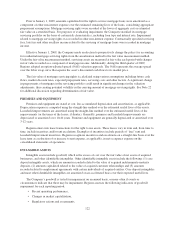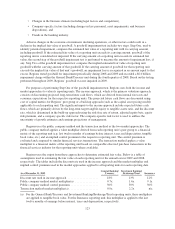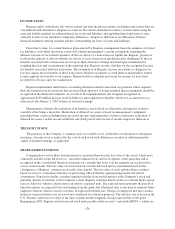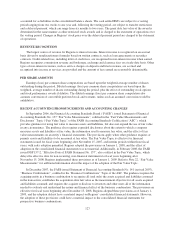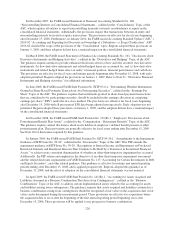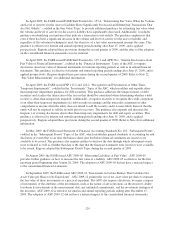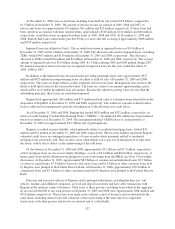Regions Bank 2009 Annual Report Download - page 142
Download and view the complete annual report
Please find page 142 of the 2009 Regions Bank annual report below. You can navigate through the pages in the report by either clicking on the pages listed below, or by using the keyword search tool below to find specific information within the annual report.In December 2007, the FASB issued Statement of Financial Accounting Standards No. 160,
“Noncontrolling Interests in Consolidated Financial Statements”, codified in the “Consolidation” Topic of the
ASC, which requires all entities to report noncontrolling (minority) interests in subsidiaries as equity in the
consolidated financial statements. Additionally, the provisions require that transactions between an entity and
noncontrolling interests be treated as equity transactions. The provisions are effective for fiscal years beginning
after December 15, 2008. Furthermore, in January 2010, the FASB issued Accounting Standard Update (“ASU”)
2010-02 “Accounting and Reporting for Decreases in Ownership of a Subsidiary—a Scope Clarification”. ASU
2010-02 clarified the scope of the provisions of the “Consolidation” topic. Regions adopted these provisions on
January 1, 2009, and their adoption did not have a material impact on the consolidated financial statements.
In March 2008, the FASB issued Statement of Financial Accounting Standards No. 161, “Disclosures about
Derivative Instruments and Hedging Activities”, codified in the “Derivatives and Hedging” Topic of the ASC.
The guidance requires entities to provide enhanced disclosures about (a) how and why an entity uses derivative
instruments, (b) how derivative instruments and related hedged items are accounted for, and (c) how derivative
instruments and related hedged items affect an entity’s financial position, financial performance and cash flows.
The provisions are effective for fiscal years and interim periods beginning after November 15, 2008, with early
adoption permitted. Regions adopted the provisions on January 1, 2009. Refer to Note 21, “Derivative Financial
Instruments and Hedging Activities” for additional information.
In June 2008, the FASB issued FASB Staff Position No. EITF 03-6-1, “Determining Whether Instruments
Granted in Share-Based Payments Transactions Are Participating Securities”, codified in the “Earnings Per
Share” Topic of the ASC. The guidance requires that instruments granted in share-based payment transactions,
that are considered to be participating securities, should be included in the earnings allocation in computing
earnings per share (“EPS”) under the two-class method. The provisions are effective for fiscal years beginning
after December 15, 2008 with all prior period EPS data being adjusted retrospectively. Early adoption was not
permitted. Regions adopted these provisions on January 1, 2009, and the adoption did not have a material impact
on the consolidated financial statements.
In December 2008, the FASB issued FASB Staff Position No. 132(R)-1, “Employers’ Disclosures about
Postretirement Benefit Plan Assets”, codified in the “Compensation – Retirement Benefits” Topic of the ASC.
The guidance requires annual disclosures about assets held in an employer’s defined benefit pension or other
postretirement plan. These provisions are generally effective for fiscal years ending after December 15, 2009.
See Note 18 for disclosures required by this guidance.
In January 2009, the FASB issued FASB Staff Position No. EITF 99-20-1, “Amendments to the Impairment
Guidance of EITF Issue No. 99-20”, codified in the “Investments” Topic of the ASC. This FSP amends the
impairment guidance in EITF Issue No. 99-20, “Recognition of Interest Income and Impairment on Purchased
Beneficial Interests and Beneficial Interests That Continue to Be Held by a Transferor in Securitized Financial
Assets,” to achieve more consistent determination of whether an other-than-temporary impairment has occurred.
Additionally, the FSP retains and emphasizes the objective of an other-than-temporary impairment assessment
and the related disclosure requirements in FASB Statement No. 115 “Accounting for Certain Investments in Debt
and Equity Securities”, and other related guidance. This guidance is effective for interim and annual reporting
periods ending after December 15, 2008, and is applied prospectively. Regions adopted this guidance as of
December 31, 2008, and the effect of adoption on the consolidated financial statements was not material.
In April 2009, the FASB issued FASB Staff Position No. 141(R)-1, “Accounting for Assets Acquired and
Liabilities Assumed in a Business Combination That Arise from Contingencies”, codified in the “Business
Combinations” Topic of the ASC, to address certain implementation issues related to the accounting for assets
and liabilities arising from contingencies. The guidance requires that assets acquired and liabilities assumed in a
business combination arising from contingencies should be recognized at fair value on the acquisition date if fair
value can be determined during the measurement period. These provisions are effective for acquisitions where
the acquisition date is on or after the beginning of the first annual reporting period beginning on or after
December 15, 2008. These provisions will be applied to any prospective business combination.
128






